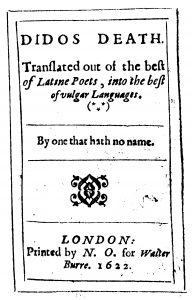Due in no small part to the repressive nature of the era, we are in the dark as to the authorship of a large body of work in the early modern period. We have already seen that all playhouse plays (except George Peele’s) were published anonymously prior to 1594, and that anonymous publication of plays remained very common throughout Shakespeare’s lifetime. These were works over whose publication writers often had no control. But the historical record reveals that even works over which writers had control were published with no author’s name attached, or with the author’s identity disguised.
 Many appeared in print under initials. Others works were published under obvious pseudonyms—Ignoto, Microcosmus—and sometimes less obvious ones, e.g. Andreas Philalethes. This practice continued well into the reign of King James I. As late as 1622, a publication called Dido’s Death bore the subtitle, ‘Translated out of the best of Latin poets into the best of vulgar languages. By one that hath no name.’ Printers and publishers, too, would often omit their names from title pages, or use only their initials. To disguise one’s identity, either partially or entirely, was a common precaution when publishing anything. Some writers clearly preferred not to have their names on their works.
Many appeared in print under initials. Others works were published under obvious pseudonyms—Ignoto, Microcosmus—and sometimes less obvious ones, e.g. Andreas Philalethes. This practice continued well into the reign of King James I. As late as 1622, a publication called Dido’s Death bore the subtitle, ‘Translated out of the best of Latin poets into the best of vulgar languages. By one that hath no name.’ Printers and publishers, too, would often omit their names from title pages, or use only their initials. To disguise one’s identity, either partially or entirely, was a common precaution when publishing anything. Some writers clearly preferred not to have their names on their works.
Click Here to Subscribe and we’ll notify you about new content.